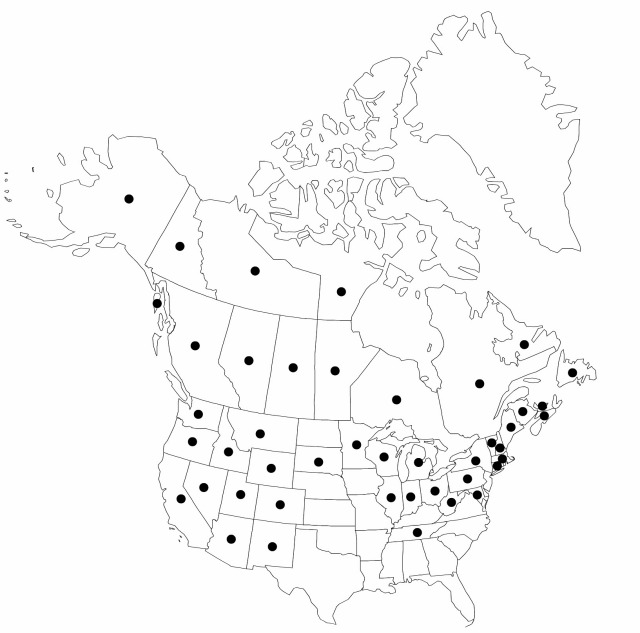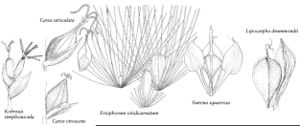Difference between revisions of "Carex utriculata"
in W. J. Hooker, Fl. Bor.-Amer. 2: 221. 1839.
FNA>Volume Importer |
RevisionBot (talk | contribs) m (Bot: Adding category Revised Since Print) |
||
| (9 intermediate revisions by 3 users not shown) | |||
| Line 1: | Line 1: | ||
{{Treatment/ID | {{Treatment/ID | ||
|accepted_name=Carex utriculata | |accepted_name=Carex utriculata | ||
| − | |accepted_authority=Boott | + | |accepted_authority=Boott |
|publications={{Treatment/Publication | |publications={{Treatment/Publication | ||
|title=in W. J. Hooker, Fl. Bor.-Amer. | |title=in W. J. Hooker, Fl. Bor.-Amer. | ||
| Line 8: | Line 8: | ||
}} | }} | ||
|common_names=Carex utriculé | |common_names=Carex utriculé | ||
| + | |special_status={{Treatment/ID/Special_status | ||
| + | |code=F | ||
| + | |label=Illustrated | ||
| + | }} | ||
|basionyms= | |basionyms= | ||
|synonyms={{Treatment/ID/Synonym | |synonyms={{Treatment/ID/Synonym | ||
|name=Carex laevirostris | |name=Carex laevirostris | ||
|authority=(Blytt ex Fries) Fries | |authority=(Blytt ex Fries) Fries | ||
| − | }}{{Treatment/ID/Synonym | + | |rank=species |
| + | }} {{Treatment/ID/Synonym | ||
|name=Carex rhynchophysa | |name=Carex rhynchophysa | ||
| − | |authority=C. A. Meyer | + | |authority=Fischer, C. A. Meyer & Avé-Lallemant |
| + | |rank=species | ||
}} | }} | ||
|hierarchy=Cyperaceae;Carex;Carex sect. Vesicariae;Carex utriculata | |hierarchy=Cyperaceae;Carex;Carex sect. Vesicariae;Carex utriculata | ||
| Line 30: | Line 36: | ||
|elevation=0–3500 m | |elevation=0–3500 m | ||
|distribution=Alta.;B.C.;Man.;N.B.;Nfld. and Labr.;N.W.T.;N.S.;Nunavut;Ont.;P.E.I.;Que.;Sask.;Yukon;Alaska;Ariz.;Calif.;Colo.;Conn.;Idaho;Ill.;Ind.;Maine;Md.;Mass.;Mich.;Minn.;Mont.;Nev.;N.H.;N.Mex.;N.Y.;N.C.;Ohio;Oreg.;Pa.;S.Dak.;Tenn.;Utah;Vt.;Va.;Wash.;W.Va.;Wis.;Wyo.;Mexico;Eurasia. | |distribution=Alta.;B.C.;Man.;N.B.;Nfld. and Labr.;N.W.T.;N.S.;Nunavut;Ont.;P.E.I.;Que.;Sask.;Yukon;Alaska;Ariz.;Calif.;Colo.;Conn.;Idaho;Ill.;Ind.;Maine;Md.;Mass.;Mich.;Minn.;Mont.;Nev.;N.H.;N.Mex.;N.Y.;N.C.;Ohio;Oreg.;Pa.;S.Dak.;Tenn.;Utah;Vt.;Va.;Wash.;W.Va.;Wis.;Wyo.;Mexico;Eurasia. | ||
| − | |discussion=<p>Carex utriculata is abundant and variable and is often a dominant of wetlands in subarctic, boreal, and north-temperate wetlands. American authors usually treat the taxon as part of the variation of Carex rostrata, but it is a very different plant with a quite different leaf shape in cross section and very different leaf anatomy. Plants from the western and northern portions of the range often have perigynia strongly tinged with purple, though that coloration can also occur rarely elsewhere.</p><!-- | + | |discussion=<p><i>Carex utriculata</i> is abundant and variable and is often a dominant of wetlands in subarctic, boreal, and north-temperate wetlands. American authors usually treat the taxon as part of the variation of <i>Carex rostrata</i>, but it is a very different plant with a quite different leaf shape in cross section and very different leaf anatomy. Plants from the western and northern portions of the range often have perigynia strongly tinged with purple, though that coloration can also occur rarely elsewhere.</p><!-- |
| − | --><p>Rarely, Carex utriculata forms hybrids with C. exsiccata, C. hystericina, C. lacustris, C. pellita, C. rostrata, C. rotundata, C. saxatilis, and C. vesicaria. The hybrids are sterile and intemediate in morphology.</p> | + | --><p>Rarely, <i>Carex utriculata</i> forms hybrids with <i>C. exsiccata</i>, <i>C. hystericina</i>, <i>C. lacustris</i>, <i>C. pellita</i>, <i>C. rostrata</i>, <i>C. rotundata</i>, <i>C. saxatilis</i>, and <i>C. vesicaria</i>. The hybrids are sterile and intemediate in morphology.</p> |
|tables= | |tables= | ||
|references= | |references= | ||
| Line 40: | Line 46: | ||
-->{{#Taxon: | -->{{#Taxon: | ||
name=Carex utriculata | name=Carex utriculata | ||
| − | + | |authority=Boott | |
| − | |authority=Boott | ||
|rank=species | |rank=species | ||
|parent rank=section | |parent rank=section | ||
| Line 54: | Line 59: | ||
|publication title=in W. J. Hooker, Fl. Bor.-Amer. | |publication title=in W. J. Hooker, Fl. Bor.-Amer. | ||
|publication year=1839 | |publication year=1839 | ||
| − | |special status= | + | |special status=Illustrated |
| − | |source xml=https:// | + | |source xml=https://bitbucket.org/aafc-mbb/fna-data-curation/src/2e0870ddd59836b60bcf96646a41e87ea5a5943a/coarse_grained_fna_xml/V23/V23_944.xml |
|genus=Carex | |genus=Carex | ||
|section=Carex sect. Vesicariae | |section=Carex sect. Vesicariae | ||
| Line 61: | Line 66: | ||
}}<!-- | }}<!-- | ||
| − | -->[[Category:Treatment]][[Category:Carex sect. Vesicariae]] | + | --> |
| + | |||
| + | [[Category:Treatment]] | ||
| + | [[Category:Carex sect. Vesicariae]] | ||
| + | [[Category:Revised Since Print]] | ||
Latest revision as of 19:36, 6 November 2020
Plants colonial; rhizomes long. Culms trigonous in cross section, 25–100 cm, smooth or somewhat scabrous-angled distally. Leaves: basal sheaths brown or lightly tinged with pinkish red, spongy-thickened; ligules as long as wide; blades pale to mid green, flat to broadly V-shaped, widest leaves 4.5–12(–15) mm wide, glabrous. Inflorescences 10–40(–50) cm; proximal bract 12–55(–75) cm, exceeding but not more than 2.5 times longer than inflorescence; proximal 2–5 spikes pistillate, erect or the proximal ascending, ca. 20–150-flowered, cylindric; terminal 2–5 spikes staminate, well elevated beyond summit of separate pistillate spikes. Pistillate scales lanceolate ovate, 2.6–5.5(–7.6) × 0.8–1.7(–2.1) mm, mostly shorter than perigynia, margins entire, apex acute to acuminate, awnless (rarely acuminate-awned). Perigynia spreading, often green or straw colored, 9–15-veined, veins running into beak, ovate, (3.2–)4–8.6 × 1.7–3 mm, apex contracted; beak (1–)1.2–2.7 mm, bidentulate, smooth, teeth straight, 0.2–1.3 mm. Stigmas 3. Achenes brown, symmetric, not indented, trigonous, smooth.
Phenology: Fruiting Jun–Aug.
Habitat: Open swamps, wet thickets, marshes, sedge meadows, bogs, fens, stream, pond, and lakeshores
Elevation: 0–3500 m
Distribution

Alta., B.C., Man., N.B., Nfld. and Labr., N.W.T., N.S., Nunavut, Ont., P.E.I., Que., Sask., Yukon, Alaska, Ariz., Calif., Colo., Conn., Idaho, Ill., Ind., Maine, Md., Mass., Mich., Minn., Mont., Nev., N.H., N.Mex., N.Y., N.C., Ohio, Oreg., Pa., S.Dak., Tenn., Utah, Vt., Va., Wash., W.Va., Wis., Wyo., Mexico, Eurasia.
Discussion
Carex utriculata is abundant and variable and is often a dominant of wetlands in subarctic, boreal, and north-temperate wetlands. American authors usually treat the taxon as part of the variation of Carex rostrata, but it is a very different plant with a quite different leaf shape in cross section and very different leaf anatomy. Plants from the western and northern portions of the range often have perigynia strongly tinged with purple, though that coloration can also occur rarely elsewhere.
Rarely, Carex utriculata forms hybrids with C. exsiccata, C. hystericina, C. lacustris, C. pellita, C. rostrata, C. rotundata, C. saxatilis, and C. vesicaria. The hybrids are sterile and intemediate in morphology.
Selected References
None.
